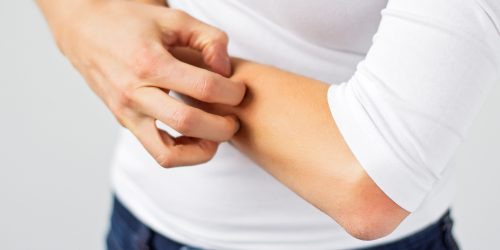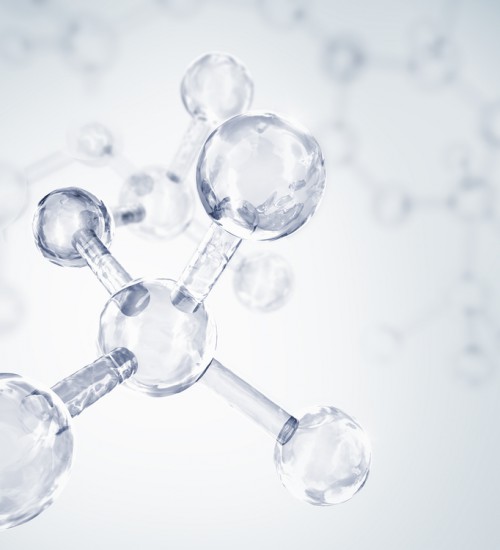DAO Deficiency
What is DAO Deficiency?
DAO deficiency is the functional lack of the main digestive enzyme responsible for the histamine elimination, a molecule found in food.
Diamine oxidase enzyme or DAO is located in the intestinal mucosa mainly, thus acts during the digestion of food.
When there is an alteration in the metabolism of histamine and there is not enough DAO activity, the imbalance between ingested histamine and histamine released from the storage cells leads to histamine accumulation in plasma and the occurrence of adverse effects on health.
The main cause of the enzymatic dysfunction has a genetic origin. Some people have or produce few Diamine Oxidase, this is the reason why until recently, migraine was believed to be hereditary, when in fact; the hereditary factor is the deficiency of DAO. Moreover, drugs or some inflammatory bowel diseases represent another factor that enables histamine decrease.



DAO deficiency symptoms
Unlike food allergy, the occurrence of symptoms or adverse effects is not linked to the intake of specific food; by contrast it can be related to a wide variety of food with different histamine contents. Symptoms can also occur even after the ingestion of products with low histamine levels. This imposed considerable difficulty when establishing a maximum tolerable dose; in fact, there is no clear consensus on this value.
Values that range from 50μg of histamine to 60-75mg have been listed as triggers of DAO deficiency symptoms. When there is an accumulation of histamine many body systems can be altered, but symptoms don’t necessarily have to appear in all patients. The most typical are:
- Nervous System: Migraine, headaches, vertigo and/or ADHD.
- Digestive System: intestinal irregularities (diarrhoea, constipation), abdominal pain and distension, reflux, nausea and/or vomiting.
- Cardiovascular System: hypotension and/or arrhythmia.
- Dermatologic System: itching, redness, edema, atopic skin and/or eczema.
- Respiratory System: nose congestion, rhinitis, asthma and/or sneezing.
- Locomotor System: muscle pain, joint pain, fibromyalgia and/or fatigue.
Due to the wide variety of symptoms derived from DAO deficiency, which represent chronic pathologies with a high prevalence in population, immediate research and advances on its origin and possible treatments are required.
It has been observed that most patients with low functional DAO activity present other related symptoms, being migraine the prevalent one. 20% of patients experience 1 or 2 of these associated symptoms, 41.3% of patients experience 3 or 4 of these symptoms and 33.8% present more than 5. Migraine is always de most highlighted syndrome when interviewing the patients due to its disabling character.
Histamine and DAO Deficiency
Histamine is a molecule derived from an essential amino acid, histidine, with many physiological and patho-physiological functions: It takes part in the regulation of local blood circulation, in capillary permeability, contraction and relaxation of smooth muscles and blood vessels, secretion of hydrochloric acid in stomach, immediate hypersensitivity responses, allergic processes, inflammatory ones as part of the immune response to external pathogens, tissue healing, and its action has also been observed as neurotransmitter in the nervous system. Therefore, and taking into consideration its multiple roles, indispensable for the efficient functioning of many metabolic processes, it is not surprising that histamine appears to a higher or lower quantity in a great variety of food, both of animal and plant origin. However, it has no function, unlike endogenous histamine.
Histamine we get through food is the most difficult to control because its regulation depends on the organism of each person. If some alteration in its metabolism occurs and normal histamine concentrations in blood do not remain (50-70 mg/l), free circulation of this amine in high concentrations triggers undesirable effects, such as migraine. In the metabolism of histamine, it should be degraded by DAO enzyme in order to become N-acetyl aldehyde imidazole; an accumulation of the amine is produced due to the lack of enzyme in the intestinal mucosa cells. Low enzyme activity causes the concentration of food histamine, which cannot be metabolized and a transepithelial permeation of exogenous histamine occurs. This way, histamine enters the bloodstream increasing its plasma concentration and once located in blood it spreads throughout the body and to the superficial arteries. Histamine acts in this area causing inflammation followed by one of the most common effects, vasodilatation, and migraine process starts. The vasodilatation caused by histamine is linked to the side effects suffered in the Nervous and Cardiovascular Systems mainly, but also in the epithelium.


How do we treat DAO Deficiency?
First of all, a special blood test is carried out to detect the enzymatic deficiency. Once confirmed, the treatment consists in a diet low in histamine and other amines that enhance its accumulation.
In the first visit, we normally recommend starting with a stage one diet, this means a stricter diet, which is completely tailor-made and delivered to the patient after the visit.
We study each case individually, since there are no two identical individuals, nor are there two identical diets. We take into account patient’s clinical history, habits, schedule, lifestyle, physical activity, preferences and economy.
In case specific dietary requirements are needed, we try to fill them through food, although this is not always possible and we resort to nutritional supplements. For example, in most cases we recommend adding omega-3 pearls, since it is difficult to find food with low content of histamine and rich in fatty acid. We also recommend to take DAO enzyme pills before each meal. Patients improve faster when combining diet and supplementation.
As the weeks go by, patients tent to observe changes and improvements and we schedule another visit. Second phase is a good sign, and means that histamine accumulation is lowering and we can broaden the diet.
When the third and final phase is reached, diet becomes freer and the patient start controlling the amount and frequency of consumption of high-histamine food.
Food and low histamine diet
Some food provokes histamine accumulation in the organism, but not all are necessarily rich in this amine.
Until now, the cause had been searched for in food as during years patients have linked several foods to migraine. Considering all the information disclosed until now, it can be concluded that the origin of this syndrome is in the individual itself, being food the access road of the component that leads to this accumulation.
There are discrepancies on the criteria that help to consider a food rich in histamine or not.
Some authors suggest eliminating from diet those foods with concentrations higher than 20 mg/kg, while other authors are more demanding and consider low histamine foods those with quantities below 1mg/kg. However, to do it correctly, the amount of histamine in food should be in the nutrition labels, and it is not.
On the other hand, in addition to the foods rich in histamine, we should take into account other factors that cause the accumulation of the amine in the body such as the amount of other amines, the ability to release endogenous histamine or DAO enzyme blocking factors such as alcoholic beverages. The following table lists the DAO deficit histamine accumulation food precursors (due to high concentration, containing other amines that compete with DAO or endogenous histamine release), but it does not replace a balanced low histamine diet, which should be advised by a professional: a registered dietitian and nutritionist.



FAQ
Through various specific analytics. Mainly the blood test that measures the functional activity of the DAO enzyme and the genetic test of the 4 variants associated with DAO deficiency of the AOC1 gene (blood or oral mucosa). In a complementary way, other parameters of histamine metabolism can be requested.
The DAO activity can be requested at any extraction center, although the main ones are the following laboratories: Synlab, Echevarne or Reference Lab. The genetic test can be requested at our clinical center or directly at VivoLabs. For outside of Spain, contact us and we will tell you which would be the best option.
Our recommendation is to consult a registered dietitian in order to obtain a personalized low histamine (and other amines that facilitate their accumulation) diet.
In most cases DAO deficiency is hereditary by a genetic mutation, however, symptoms improve with the treatment. On the other hand, there are cases of DAO deficiency acquired. These patients can increase the DAO activity.
Combining therapeutic diet with one tablet of DAO before main meals improves patient progress. It also allows timely introductions from the 2nd phase of treatment.
All four supplements are foods for special medical purposes. They all contain protein extract with DAO enzyme, but Daofood® contains only DAO enzyme and the presentation is in dispenser format, Daofood Plus® contains vitamin C and quercetin and Daohead® contains caffeine, vitamin B6, B9 and B12.
The GoDAO® is the most innovative product (2024) and we helped in its design from the International Institute of DAO deficiency. There are 90 mini-tablets instead of 60, it comes in 3 protected blisters of 30 mini-tablets each and its activity, potency and stability are greater. See more
Mainly you should avoid the consumption of fermented foods such as sausages, cured cheeses, sauerkraut and alcoholic beverages. It is also important to reduce the consumption of citrus fruits, chocolate and milk.
They can be consumed if they do not contain histamine in their natural form and especially if they are not ultra-processed products.
